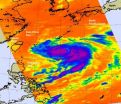(Press-News.org) ROCHESTER, Minn. -- The drug pazopanib may help revolutionize the care of patients with metastatic, rapidly progressive differentiated thyroid cancers, say researchers at Mayo Clinic who are publishing findings of a phase II clinical trial in The Lancet Oncology.
VIDEO ALERT: Additional audio and video resources, including excerpts from an interview with Dr. Keith Bible describing the research, are available on the Mayo Clinic News Blog. Password: bible.
The researchers studied 37 patients with the most aggressive form of this cancer -- developing in less than 5 percent of patients with differentiated thyroid cancer -- and found that about half (18) patients had a long-lasting response to pazopanib. Of that group, 12 are still alive without disease progression. The median progression-free survival time was 11.7 months, with an overall survival rate of 81 percent at one year.
The researchers say that, to their knowledge, these findings represent by far the highest response rate yet reported in such aggressive cases of differentiated thyroid cancer. They caution however, that this drug is not meant to be used in slow-growing differentiated thyroid cancers and that they cannot assess the survival advantage pazopanib offers to the patients studied.
Determining survival benefit would require a randomized clinical trial testing the agent, which inhibits all three vascular endothelial growth factor (VEGF) receptors, compared to other treatments or a placebo.
"In this group of patients, we would have expected the cancer to have progressed in everyone within six months, but instead the median time to progression was almost a year in
response to pazopanib therapy," says Keith Bible, M.D., Ph.D., a medical oncologist and researcher who led the multicenter clinical trial, funded by the National Cancer Institute. Most of the patients treated were enrolled at Mayo Clinic campuses in Minnesota and Florida.
But as encouraging as this response is, it does not come without the potential for significant side effects, Dr. Bible says. The drug dose used in 16 patients had to be lowered because side effects were judged by oncologists to become potentially threatening or debilitating, and two patients experienced significant bleeding. Further, although two patients died in association with pre-existing disease while enrolled in the study, the agent could have contributed in some way, he says.
"Further studies of pazopanib in advanced thyroid cancer remain ongoing at Mayo Clinic and associated cancer centers to continue to learn more about how best to use the drug in these cancers," Dr. Bible says. "Such clinical trials also may provide patients access to this drug, which otherwise may be unobtainable due to cost, given that it is not yet approved for use in thyroid cancers."
Plans are underway for a larger phase III clinical trial with aggressive differentiated thyroid cancer patients that will be centered in Europe, with some sites to be opened in the U.S.
The authors declare no conflicts of interest. The manufacturer of pazopanib (GlaxoSmithKline) did not provide funding or other material support to the researchers and did not have access to the data.
INFORMATION:
For more information on Mayo Clinic Cancer Center clinical trials, call 507-538-7623 or visit http://clinicaltrials.mayo.edu/.
Targeted therapy decreases progression rate in thyroid cancer
Given potential side effects, patients with slow-growing thyroid cancer should not use pazopanib
2010-09-18
ELSE PRESS RELEASES FROM THIS DATE:
Report: Tsunami detection improves, but coastal areas still vulnerable
2010-09-18
WASHINGTON — The nation's ability to detect and forecast tsunamis has improved since the 2004 Indian Ocean tsunami, but current efforts are still not sufficient to meet challenges posed by tsunamis generated near land that leave little time for warning, says a new congressionally requested report from the National Research Council. The report calls for a comprehensive national assessment of tsunami risk and improved communication and coordination among the two federal Tsunami Warning Centers, emergency managers, media, and the public.
"For a tsunami warning system ...
Channeling efforts to fight cystic fibrosis
2010-09-18
PHILADELPHIA - The lab of Kevin Foskett, PhD, the Isaac Ott Professor of Physiology at the University of Pennsylvania School of Medicine, has found a possible new target for fighting cystic fibrosis (CF) that could compensate for the lack of a functioning ion channel in affected CF-related cells. Their finding appears in the Journal of Clinical Investigation.
The team explored the role of CFTR, the chloride ion channel mutated in CF patients, in fluid secretion by mucous gland cells. They used a recently developed transgenic pig model, in which the CFTR gene has been ...
Women with diabetes having more C-sections and fetal complications: study
2010-09-18
TORONTO, September 17, 2010 – Nearly half of women with diabetes prior to pregnancy have a potentially-avoidable C-section and their babies are twice as likely to die as those born to women without diabetes, according to the POWER study.
Researchers from St. Michael's Hospital, the Institute for Clinical Evaluative Sciences (ICES) and Women's College Hospital say rates of diabetes in Ontario have doubled in the last 12 years. Nearly one in 10 Ontario adults has been diagnosed with diabetes, including more women than ever before.
As women develop type 2 diabetes (adult ...
Progress against child deaths will lag until family, community care prioritized
2010-09-18
Global efforts to tackle millions of preventable child and maternal deaths will fail to extend gains unless world leaders act now to pour more healthcare resources directly into families and communities, according to a new World Vision report launched today.
"The Missing Link: Saving children's lives through family care" examines how the resources invested to achieve Millennium Development Goals (MDGs) 4 and 5 can go further toward saving the more than 8 million children under the age of five and 350,000 mothers who die each year, mostly from preventable causes. Undertaken ...
NASA eyes Typhoon Fanapi approaching Taiwan
2010-09-18
Infrared satellite data from NASA's Aqua satellite revealed strong convection and a tight circulation center within Typhoon Fanapi as it heads for a landfall in Taiwan this weekend.
At 1500 UTC (10 a.m. EDT) on Sept. 17, Typhoon Fanapi's maximum sustained winds were near 85 knots (97 mph). It was centered about 360 nautical miles east-southeast of Taipei, Taiwan near 23.2 North and 127.4 East. It is churning up high seas up to 22 feet.
NASA's Aqua satellite passed over Typhoon Fanapi on September 17 at 04:45 UTC (12:45 a.m. EDT) and captured an infrared image of its ...
Tick tock: Rods help set internal clocks, biologist says
2010-09-18
We run our modern lives largely by the clock, from the alarms that startle us out of our slumbers and herald each new workday to the watches and clocks that remind us when it's time for meals, after-school pick-up and the like.
In addition to those ubiquitous timekeepers, though, we have internal "clocks" that are part of our biological machinery and which help set our circadian rhythms, regulating everything from our sleep-wake cycles to our appetites and hormone levels. Light coming into our brains via our eyes set those clocks, though no one is sure exactly how this ...
NASA's CloudSat satellite and GRIP Aircraft profile Hurricane Karl
2010-09-18
NASA's CloudSat satellite captured a profile of Hurricane Karl as it began making landfall in Mexico today. The satellite data revealed very high, icy cloud tops in Karl's powerful thunderstorms, and moderate to heavy rainfall from the storm. Meanwhile, NASA's "GRIP" mission was also underway as aircraft were gathering valuable data about Hurricane Karl as he moves inland.
NASA's Genesis and Rapid Intensification Processes mission (known as GRIP) is still underway and is studying the rapid intensification of storms, and that's exactly what Karl did on Thursday Sept. ...
NASA sees record-breaking Julia being affected by Igor
2010-09-18
Julia is waning in the eastern Atlantic Ocean because of outflow from massive Hurricane Igor, despite his distance far to the west. Satellite imagery from NASA's Aqua satellite showed that Julia's eye was no longer visible, a sign that she's weakening.
As NASA's Aqua satellite flew over Hurricane Julia from space on Sept. 16 at 1:35 p.m. EDT, the Moderate Resolution Imaging Spectroradiometer (MODIS) instrument captured a visible image of the storm. In the MODIS image, Julia's eye was no longer visible and its center was cloud-filled.
Although Julia is weakening from ...
Pickle spoilage bacteria may help environment
2010-09-18
Spoilage bacteria that can cause red coloration of pickles' skin during fermentation may actually help clean up dyes in textile industry wastewater, according to a U.S. Department of Agriculture (USDA) study.
Some species of Lactobacilli-food-related microorganisms-can cause red coloring when combined with tartrazine, a yellow food-coloring agent used in the manufacture of dill pickles. Now Agricultural Research Service (ARS) microbiologist Ilenys Pérez-Díaz and her colleagues have found that these spoilage Lactobacilli also may have environmental benefits. ARS is ...
Gene limits learning and memory in mice
2010-09-18
Deleting a certain gene in mice can make them smarter by unlocking a mysterious region of the brain considered to be relatively inflexible, scientists at Emory University School of Medicine have found.
Mice with a disabled RGS14 gene are able to remember objects they'd explored and learn to navigate mazes better than regular mice, suggesting that RGS14's presence limits some forms of learning and memory.
The results were published online this week in the Early Edition of the Proceedings of the National Academy of Sciences.
Since RGS14 appears to hold mice back mentally, ...
LAST 30 PRESS RELEASES:
Decoupling the HOR enhancement on PtRu: Dynamically matching interfacial water to reaction coordinates
Sulfur isn’t poisonous when it synergistically acts with phosphine in olefins hydroformylation
URI researchers uncover molecular mechanisms behind speciation in corals
Chitin based carbon aerogel offers a cleaner way to store thermal energy
Tracing hidden sources of nitrate pollution in rapidly changing rural urban landscapes
Viruses on plastic pollution may quietly accelerate the spread of antibiotic resistance
Three UH Rainbow Babies & Children’s faculty elected to prestigious American Pediatric Society
Tunnel resilience models unveiled to aid post-earthquake recovery
Satellite communication systems: the future of 5G/6G connectivity
Space computing power networks: a new frontier for satellite technologies
Experiments advance potential of protein that makes hydrogen sulfide as a therapeutic target for Alzheimer’s disease
Examining private equity’s role in fertility care
Current Molecular Pharmacology achieves a landmark: real-time CiteScore advances to 7.2
Skeletal muscle epigenetic clocks developed using postmortem tissue from an Asian population
Estimating unemployment rates with social media data
Climate policies can backfire by eroding “green” values, study finds
Too much screen time too soon? A*STAR study links infant screen exposure to brain changes and teen anxiety
Global psychiatry mourns Professor Dan Stein, visionary who transformed mental health science across Africa and beyond
KIST develops eco-friendly palladium recovery technology to safeguard resource security
Statins significantly reduce mortality risk for adults with diabetes, regardless of cardiovascular risk
Brain immune cells may drive more damage in females than males with Alzheimer’s
Evidence-based recommendations empower clinicians to manage epilepsy in pregnancy
Fungus turns bark beetles’ defenses against them
There are new antivirals being tested for herpesviruses. Scientists now know how they work
CDI scientist, colleagues author review of global burden of fungus Candida auris
How does stroke influence speech comprehension?
B cells transiently unlock their plasticity, risking lymphoma development
Advanced AI dodel predicts spoken language outcomes in deaf children after cochlear implants
Multimodal imaging-based cerebral blood flow prediction model development in simulated microgravity
Accelerated streaming subgraph matching framework is faster, more robust, and scalable
[Press-News.org] Targeted therapy decreases progression rate in thyroid cancerGiven potential side effects, patients with slow-growing thyroid cancer should not use pazopanib



